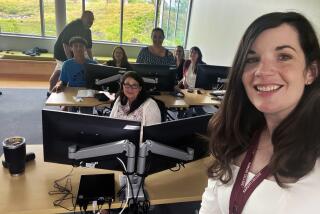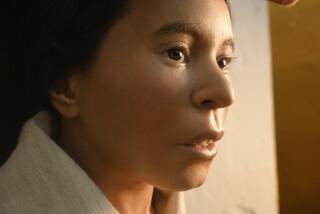Alien mystery solved: Tiny skeleton belonged to a human girl with rare genetic defects
In the 15 years since it was found in an abandoned mining town in Chile’s Atacama Desert, the bizarre 6-inch skeleton has inspired fervid speculation, including theories of unearthly origins.
It had 10 pairs of ribs — two fewer than the normal human complement — and an elongated skull with a pronounced point. Despite its diminutive size, the proportion of its limbs and torso suggested this was a human. Was this a stillborn baby? A nonhuman primate of some sort? An alien being?
Now, genetic science has given these mummified remains a species (Homo sapiens), a gender (female), an age (she probably died shortly after birth) and as many as 52 genetic clues to her extreme physical abnormalities (her bones appear to have aged at an accelerated pace).
Not surprisingly, it has also narrowed her ancestry to a mix of peoples typical of those who settled the remote corner of Chile in which her remains were found lovingly tucked into a pouch. Her genes suggest her ancestry was largely European and, to a lesser extent, East Asian.
The mummified skeleton has been called “Ata,” and, starting roughly four years ago, researchers from Stanford University and UC San Francisco isolated and purified its DNA from marrow inside its tiny, preserved bones. Then they put a new generation of genetic sequencing technology to work.
Some of the genetic mutations they found have not been recorded before — not so surprising in a field in which the function of most genes, and of whole genetic regions, remains a mystery. Some mutations were probably carried and bequeathed by one parent only. Others appear to have been contributed by both.
Still other mutations may have arisen spontaneously — a mystery that, in the absence of Ata’s parents’ genes, will probably endure.
But among the welter of mutations they found were half a dozen or more abnormalities in genes known to be associated with conditions such as dwarfism, scoliosis and musculoskeletal abnormalities. During fetal development, and possibly in the few days of life she probably survived, those appear to have caused her bones to fuse and age at an unusual pace.
By the time she succumbed, probably to breathing or feeding difficulties or complications of a likely premature birth, the infant’s bones and the ways in which they had fused gave her the skeletal structure of a child between 6 and 8 years old.
The number of mutations affecting bone structure and growth was “well beyond what you’d expect by chance,” said Stanford researcher Garry Nolan, the first academic researcher to be called in on the Ata case.
The authors of the study, published Thursday in the journal Genome Research, speculated that the nitrate mining that had drawn settlers to the region in which Ata was found may have exposed her pregnant mother to some environmental toxin that contributed to the genetic wreckage.
But it may as easily have been a chance event.
When it came to genetic mutations affecting the structure and growth of bones, said Nolan, the child won a sort of grim lottery, “which unfortunately was a death sentence.”
“It’s rare — very, very rare” to find so many mutations related to the same systems in a single person, he said. “But if you roll the dice enough times you’re going to come up snake eyes. And that’s what happened with this unfortunate child.”
Nolan was first asked by a documentary filmmaker to consult on the case of Ata’s remains, which had made their way into a private collection in Barcelona, Spain. The producers of the film, titled “Sirius,” suggested it was evidence of alien life on Earth.
“This ended up on our doorstop like a basket,” said Nolan, who directs the National Heart, Lung and Blood Institute’s Proteomics Center for Systems Immunology at Stanford. “It first was a curiosity. Then, it became a learning opportunity, a chance to ask questions without presupposing an answer.”
Dr. Matthew L. Warman, an expert on skeletal genetic disorders at Boston Children’s Hospital and Harvard University, cautioned that although the researchers identified known and novel genetic variants, they are far from knowing what role, if any, they played in Ata’s many abnormalities.
It’s possible that the genetic variants identified in the new research could be responsible for one or more of Ata’s abnormalities, said Warman, who was not involved in the study. But if he were advising Ata’s bereaved parents or immediate relatives on what her genetic condition told them about their own risks, “I would be very cautious to use any of the data presented in this paper to draw any conclusions,” he said.
“These data by themselves, other than telling me that Ata is female, human and likely of Chilean descent, do not help me understand why she appears as she does,” says Warman.
Even with so many unanswered questions, the remains of a child like Ata can offer scientists some valuable lessons about genetics, said Dr. Atul Butte, who conducted the DNA sequencing for the new study.
“Kids come in all the time now with unusual syndromes, and we use genetic analysis to help explain what we’re seeing,” said Butte, a professor of medicine and expert in pediatric genetic diseases at UC San Francisco. “Most of the time we’re looking for one gene that’s gone wrong.”
What geneticists are learning, Butte said, “is that you shouldn’t stop at one. There might be many mutations” that contribute to an observed abnormality. It happens, as Ata’s case seems to demonstrate.
“We tend to love Occam’s razor,” the philosophical principle that challenges scientists to look for the simplest explanation to a problem, Butte said. “But maybe there’s more than one thing wrong.”
Nolan, a professor of microbiology and immunology at Stanford, sees other lessons emerging from Ata’s tiny remains. By offering evidence for the combined effects of recognized genetic mutations, the study of Ata might guide medical scientists in devising ways to grow bone more quickly. Or it may prompt geneticists to devise a prenatal test that could diagnose some or all of Ata’s abnormalities at the fetal stage, he said.
Nolan said it certainly gives scientists an instructive case study in one of genetic science’s thorniest problems: how to align what they find in the genes with the traits they see in the person (in scientific parlance, how to link genotype with phenotype).
Butte is deeply cautious about scientists’ ability to do that anytime soon.
In his day job, he has seen a single genetic mutation in children with grievous abnormalities, and mutations in “entire chunks of DNA” in children with few, if any, negative effects.
“I still don’t think we understand how unusual ‘normal’ humans can be,” Butte said. “There still could be very many differences in humans than we understand. If it’s not humbling it should be humbling. We’re not even close to that yet.”
MORE IN SCIENCE
The Great Pacific Garbage Patch counts 1.8 trillion pieces of trash, mostly plastic
Modified Pap tests can show early warning signs of other gynecological cancers
Scientists build a robotic fish to spy on ocean life
UPDATES:
1:45 p.m.: This story has been updated with comments from Dr. Matthew L. Warman of Boston Children’s Hospital.
This story was originally published at 10 a.m.






